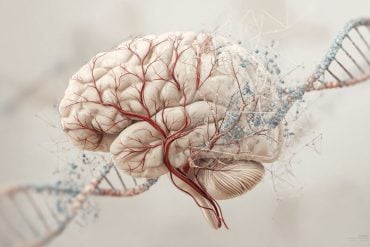Summary: A large-scale meta-analysis reveals men and women’s brains do have slight differences. However, the differences are due to brain size and not sex or gender. Researchers say brain differences between men and women are small and inconsistent once an individual’s head size is accounted for.
Source: Rosalind Franklin University
How different are men and women’s brains? The question has been explored for decades, but a new study led by Rosalind Franklin University neuroscientist Lise Eliot is the first to coalesce this wide-ranging research into a single mega-synthesis. And the answer is: hardly at all.
“Men and women’s brains do differ slightly, but the key finding is that these distinctions are due to brain size, not sex or gender,” Dr. Eliot said. “Sex differences in the brain are tiny and inconsistent, once individuals’ head size is accounted for.”
The unusually large study of studies, “Dump the ‘dimorphism’: Comprehensive synthesis of human brain studies reveals few male-female differences beyond size,” published in Neuroscience and Biobehavioral Reviews, finds that size is the only clear-cut difference between male and female brains.
Women’s brains are about 11% smaller than men’s, in proportion to their body size. Smaller brains allow certain features, such as a slightly higher ratio of gray matter to white matter, and a higher ratio of connections between, versus within, cerebral hemispheres.
“This means that the brain differences between large- and small-headed men are as great as the brain differences between the average man and woman,” Dr. Eliot said. “And importantly, none of these size-related differences can account for familiar behavioral differences between men and women, such as empathy or spatial skills.”
This is not the story typically publicized about sex differences in the human brain.
“Since the dawn of MRI, studies finding statistically significant sex differences have received outsized attention by scientists and the media,” said Dr. Eliot, whose books include “Pink Brain, Blue Brain: How Small Differences Grow Into Troublesome Gaps.”
“Researchers have been quietly accumulating massive amounts of data comparing male and female brains, but it’s only the differences that get hyped,” Dr. Eliot continued. “Unlike other areas of health research, women have been equally included in brain imaging from the outset.”
Dr. Eliot and her collaborators — fourth-year Chicago Medical School students Adnan Ahmed, Hiba Khan and Julie Patel — conducted a meta-synthesis of three decades of research, assimilating hundreds of the largest and most highly-cited brain imaging studies addressing 13 distinct measures of alleged sex difference.
For nearly every measure, they found almost no differences that were widely reproduced across studies, even those involving thousands of participants. For example, the volume or thickness of specific regions in the cerebral cortex is often reported to differ between men and women. However, the meta-synthesis shows that the regions identified differ enormously between studies.
Male-female brain differences are also poorly replicated between diverse populations, such as Chinese versus American, meaning there is no universal marker that distinguishes men and women’s brains across the human species.
“The handful of features that do differ most reliably are quite small in magnitude,” Dr. Eliot said. “The volume of the amygdala, an olive-sized part of the temporal lobe that is important for social-emotional behaviors, is a mere 1% larger in men across studies.”
The study also rebuts a longstanding view that men’s brains are more lateralized, meaning each hemisphere acts independently, whereas women’s two hemispheres are said to be better connected and to operate more in sync with each other. Such a difference could make males more vulnerable to disability following brain injury such as stroke.
Here again, the consensus of many studies shows that the difference is extremely small, accounting for even less than 1% of the range of left-right connectivity across the population.
This finding does agree with large datasets that have found no gender difference in aphasia, or the loss of language, following a stroke in the left hemisphere, contrary to long belief.
A last focus of the new study is on functional MRI. This method allows neuroscientists to see areas that “light up” during particular mental tasks and has been widely used to look for male-female differences during language, spatial and emotional tasks.

Across hundreds of such studies, Dr. Eliot’s team found extremely poor reliability in sex difference findings — nearly all specific brain areas that differed in activity between men and women were not repeated across studies. Such poor reproducibility agrees with recent research out of Stanford University demonstrating “false discovery,” or the over-publication of false-positive findings in the scientific literature on functional MRI sex difference.
“Sex comparisons are super easy for researchers to conduct after an experiment is already done. If they find something, it gets another publication. If not, it gets ignored,” Dr. Eliot said. Publication bias is common in sex-difference research, she added, because the topic garners high interest.
“Sex differences are sexy, but this false impression that there is such a thing as a ‘male brain’ and a ‘female brain’ has had wide impact on how we treat boys and girls, men and women,” Dr. Eliot said.
“The truth is that there are no universal, species-wide brain features that differ between the sexes. Rather, the brain is like other organs, such as the heart and kidneys, which are similar enough to be transplanted between women and men quite successfully.”
About this neuroscience research news
Source: Rosalind Franklin University
Contact: Dan Moran – Rosalind Franklin University
Image: The image is in the public domain
Original Research: Open access.
“Dump the “dimorphism”: Comprehensive synthesis of human brain studies reveals few male-female differences beyond size” by Lise Eliot et al. Neuroscience and Biobehavioral Reviews
Abstract
Dump the “dimorphism”: Comprehensive synthesis of human brain studies reveals few male-female differences beyond size
With the explosion of neuroimaging, differences between male and female brains have been exhaustively analyzed.
Here we synthesize three decades of human MRI and postmortem data, emphasizing meta-analyses and other large studies, which collectively reveal few reliable sex/gender differences and a history of unreplicated claims.
Males’ brains are larger than females’ from birth, stabilizing around 11 % in adults. This size difference accounts for other reproducible findings: higher white/gray matter ratio, intra- versus interhemispheric connectivity, and regional cortical and subcortical volumes in males. But when structural and lateralization differences are present independent of size, sex/gender explains only about 1% of total variance.
Connectome differences and multivariate sex/gender prediction are largely based on brain size, and perform poorly across diverse populations. Task-based fMRI has especially failed to find reproducible activation differences between men and women in verbal, spatial or emotion processing due to high rates of false discovery.
Overall, male/female brain differences appear trivial and population-specific. The human brain is not “sexually dimorphic.”






